Whether you are going to a university or a local college, you will have to write a reflection paper at some point. A reflection paper is a common type of paper. Almost every subject you take requires you to express your thoughts on specific topics. The article will help you on how to write a good reflection paper with examples and helpful tips to make your writing process more manageable.
This one offers better opportunities to speak your mind among all the tasks you will undertake during your college and university years. It allows us to look at things in our way and express opinions with others.
What is a reflection paper?
Table of Contents
It is a type of paper in which you must write your opinion on a topic and back it up with observations and personal examples. Instead of presenting your reader with other academics and writers’ views, you have the opportunity to write your point of view in this essay. it is your responsibility to express it understandably and concisely to any readers who will read your paper.
Types of reflection paper
If you genuinely want to learn how to write a reflection paper, you must first understand what type of paper you must write. While the primary objective of most reflection papers will be the same, to showcase your ideas and opinions, there are a few different kinds you may be required to complete.
Here are some types of reflection papers that can be assigned to you at some point:
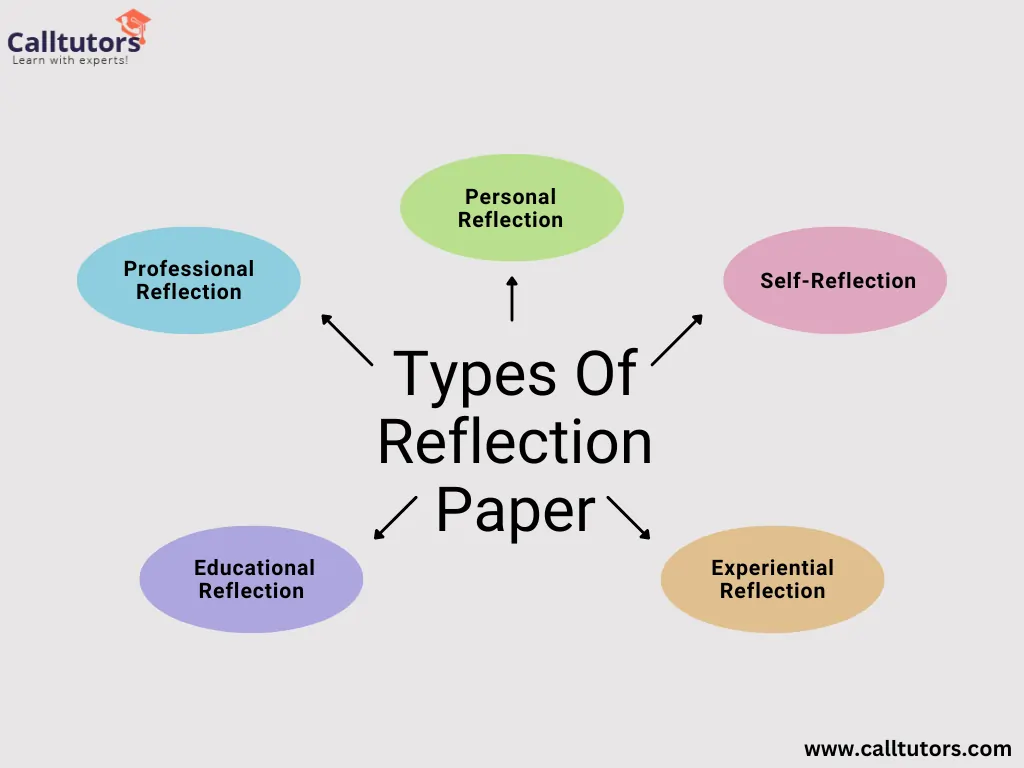
- Educational Reflection: This is very common type of reflection paper you are assigned at university or college. Your answer to a book, movie, article, or lecture is an educational reflection that shows what you have learned and how you understand the subject.
- Professional Reflection: To analyze professional behavior and development in a particular setting, a kind of thought generally employed in teaching and social work.
- Personal Reflection: You will explore your views, thoughts, and feelings about a particular topic in a personal reflection.
- Self-Reflection: You may be required to write a self-reflection at some point. It will usually be assigned at the end of a class after an important project or presentation. This type of reflection does not have to be as formal and is usually how your teacher checks out the way you learned and grew up in the classroom.
- Experiential Reflection: In general, when theory is applied to practice in healthcare or business fields, experiential reflection requires that you take concepts that you have studied and interact them with practical experience within the field.
Steps for writing a reflection paper
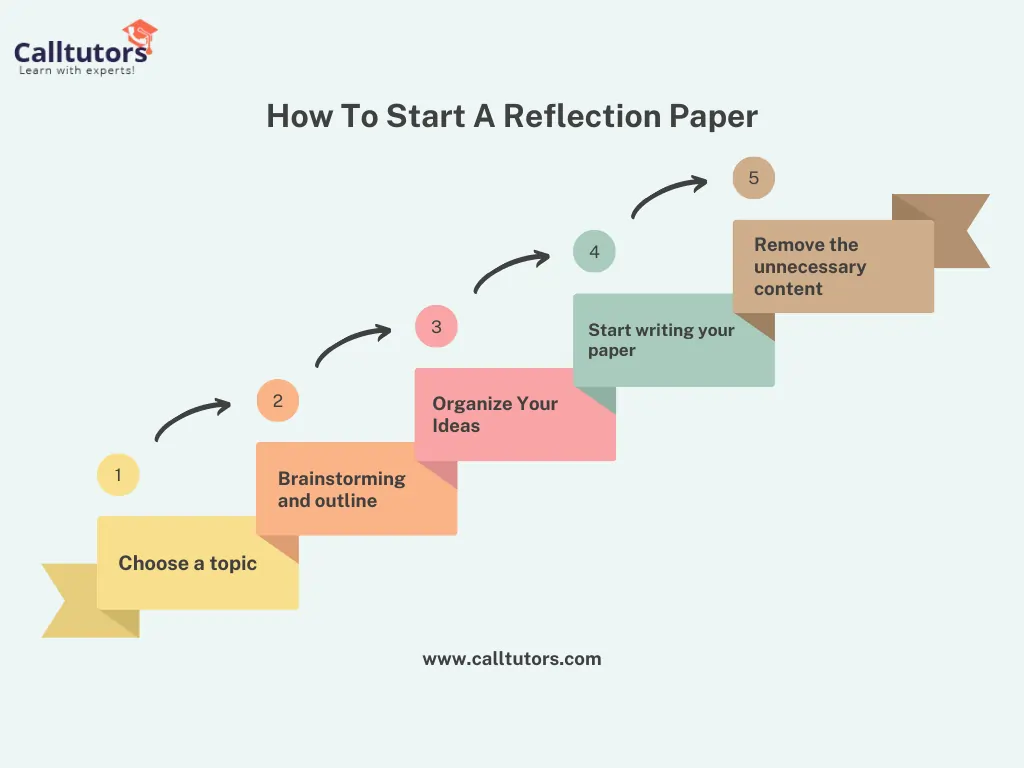
You should be reflective rather than descriptive in your writing. A reflective paper deals with learning, research, and explanation. Remember that your behavior is essential.
Writing a reflective paper is as easy as following the step-by-step instructions below, known as a reflection paper or reflective paper.
Some steps we explain below for writing a reflection paper :
Choose A Topic
Your teacher will usually assign the topic for an educational or academic study paper. It is often a book, movie, or lecture you studied in the classroom. Your task is to write about personal experiences with the topic.
It’s nice to have your own space. However, deciding on the right topic can be challenging at times.
Brainstorming And Outline
Taking notes is an essential part of writing a good reflection paper. It organizes your thoughts so you can finish your draft version as quickly as possible.
To begin, write down your central theme or reflection and how much it relates to your topic.
Make a list of potential supporting arguments. Such as-
- Personal stories
- Stories you’ve heard
- Historical events
- Current Events, Quotes, and so on
Remember that the purpose of a reflection paper is to present your viewpoints. Personal reflections should be the focus of your essay. Quotes and events can help to strengthen your arguments, but they should not be the primary focus.
Organize Your Ideas
You should now have a rough bullet list of ideas for your reflection essay. It’s now time to organize them and make them “flow.” Here’s how to structure your outline:
- Ask a Reflective Question
- Create a Strong Introduction
- Concentrate on a Thesis
- Explain the concept in the body
- Finish with a conclusion
Start Writing Your Paper
Now comes the exciting part. You’ve got your outline understood and ready to go. Now it is time to write.
Fill out each section as quickly as you can. It makes no difference whether it sounds good or not. Don’t let your fingers rest on the keyboard. Get everything out.
Remove The Unnecessary Content
Let’s clean up the mess you’ve made on the paper. Following things to keep in mind as you go through the editing process:
- Everyone writes a reflective essay in their unique style. Don’t try to copy the style of someone else. Because it is your opinion, express it!
- The majority of reflection papers range in length from 250 to 750 words. Don’t jump off on tangents. Include only necessary information.
- Create a paper that is as clear and concise as possible. Use a compelling thesis statement to keep your essay on track.
- Even if the writing is personal, use a professional and academic tone.
- To support your personal opinions, try to cite authoritative resources and experts.
- Examine your work for spelling and grammatical mistakes. Remove any unnecessary data. Make it flow by using transition phrases. Also, make sure to respond to the introduction’s question.
Format of a reflection paper
Reflection papers do not generally follow a particular format. Since it is your view, teachers typically allow you to deal with them any way you can. It is preferable to write your thoughts freely, without any guidelines.
The paper’s format may depend on the criteria your teacher has created if your review paper has been assigned to you. College reflection papers (also referred to as reflection essays) typically have a length of between 400-800 words.
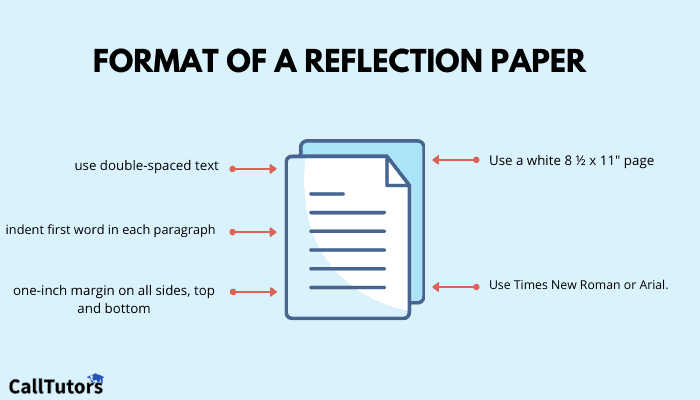
- Use a white 8 ½ x 11″ page
- Make a one-inch margin on all sides, top and bottom
- In each paragraph, indent the first word.
- Use Times New Roman or Arial.
- 12-point size is acceptable.
- The entire text should be double-spaced.
Reflection Paper Example
These are the following reflection paper samples, it is such as;
1. Reflection Paper Sample:- Reflection on Personal Learning Experience
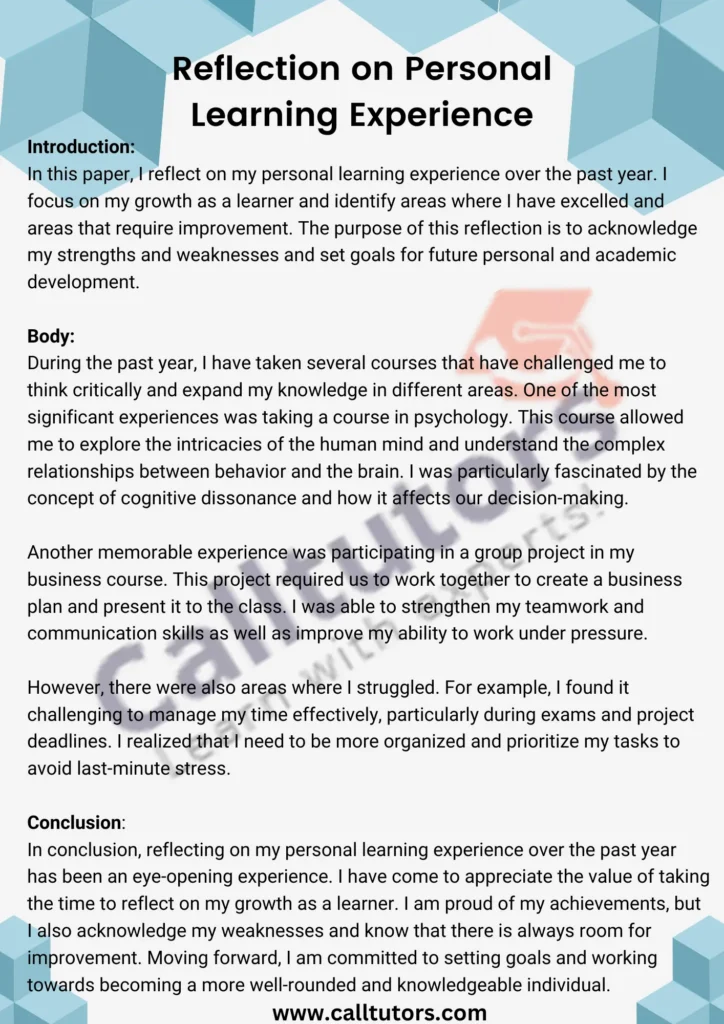
2. Reflection Paper Sample:- Reflection on Cultural Diversity
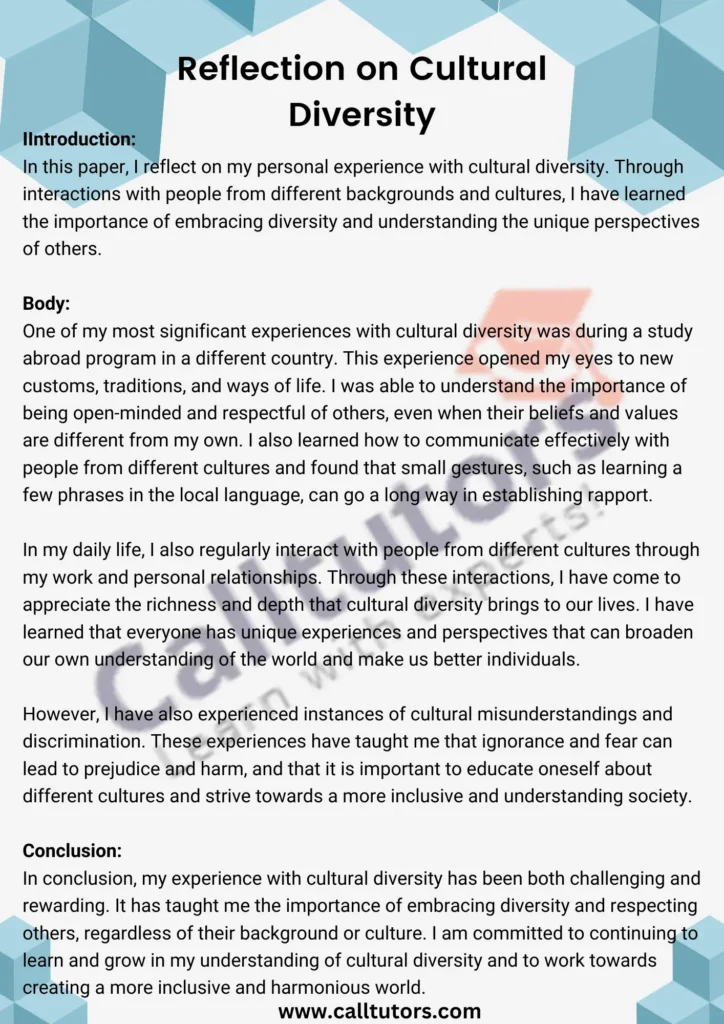
3. Reflection Paper Sample:- Reflection on Leadership Experience
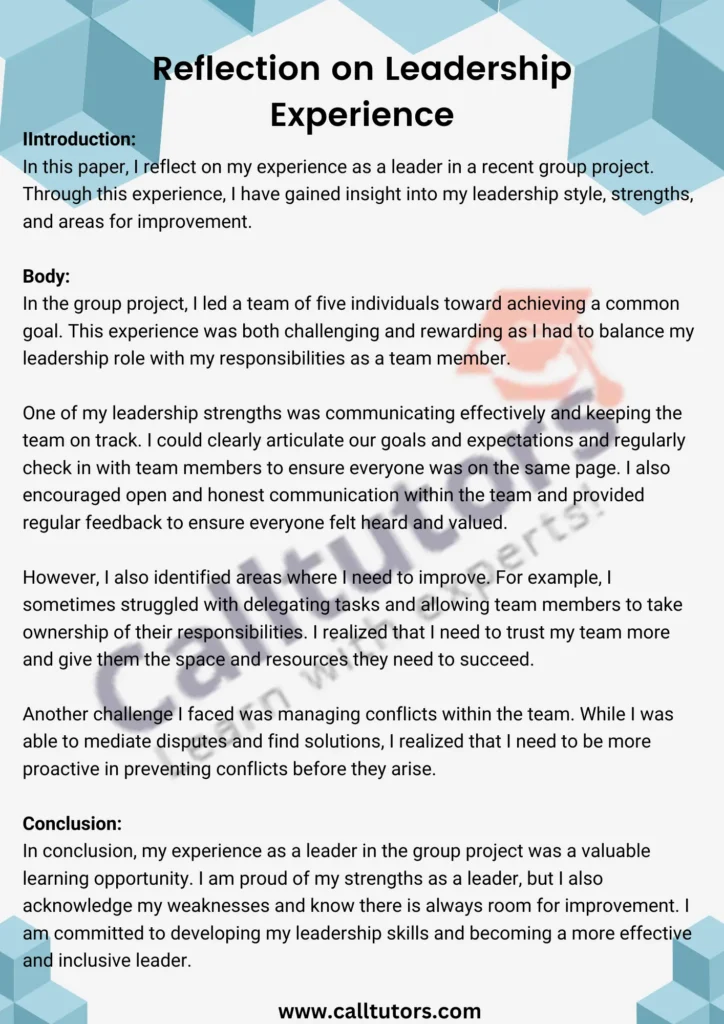
4. Reflection Paper Sample:- Reflection on Communication Skills

5. Reflection Paper Sample:- Reflection on Learning a New Skill
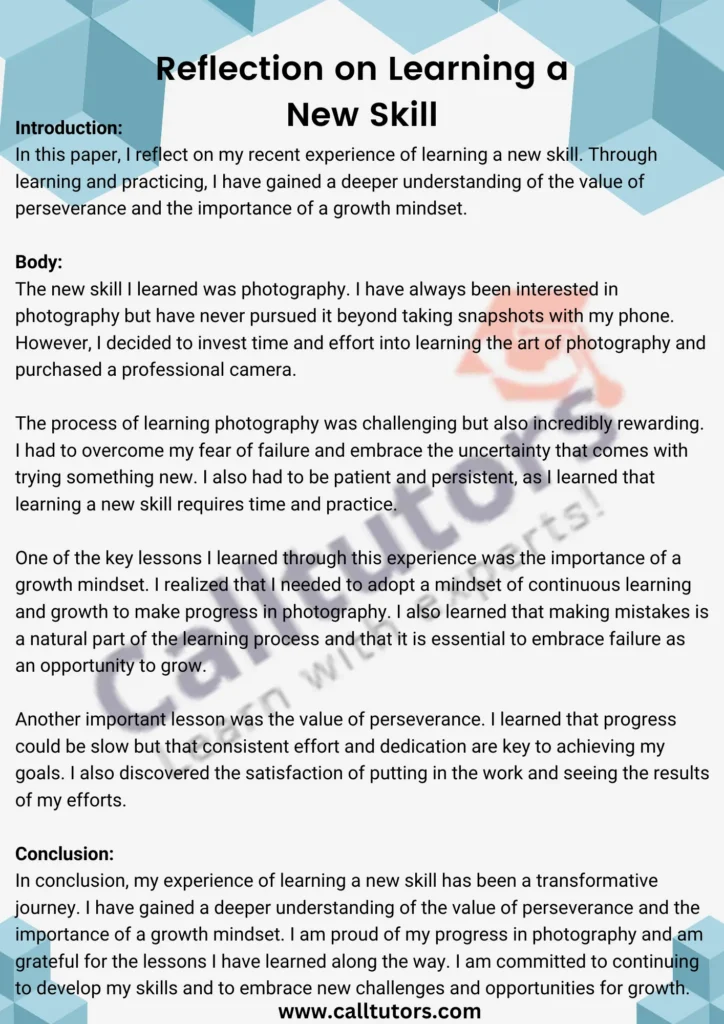
How to start your reflection paper?
First, you must carefully read your article and take notes when writing a reflection essay.
By summarizing your notes’ basic concept, you may start writing your reflection paper to see if your paper contains all the information your readers need.
It is helpful to add charts, diagrams, and lists to give the audience your ideas better.
Tips for writing the reflection paper
In reflection, the final purpose of writing is to use your own experiences, ideas, and beliefs to establish personal relationships with materials or subjects and realize how these personal perceptions form how information is consumed.
- Pick only specific topics from the text, quote them, and analyze all the points with your perception.
- Don’t write down your life story relating to a specific issue. The reader must only know your experiences or beliefs if it is directly related to the point you make or associate with them.
- Consider your paper’s length requirements. When you work with a smaller length, like 500 words, try to stay focused on essential points.
- Don’t just write a complete essay. You can start with an outline and add ideas every day on the day it was assigned.
- After you’ve completed all of your other tasks, write your introduction. By that point, your thoughts are clear, and you know where they are going.
- Think of the best readings and materials. Decide why it is memorable for your subject.
What Is An Outline For Reflection Paper?
An outline for a reflection paper can include the following main sections:
Outline For Reflection Paper
| I. Introduction | A. Background information B. Purpose of the reflection C. Thesis statement |
| II. Body | A. Description of the experience or situation being reflected upon B. Analysis of the experience or situation 1. Thoughts and emotions experienced during the event 2. What was learned from the experience? C. Reflection on the impact of the experience. 1. How has it changed the writer’s perspective? 2. How has it influenced personal or professional growth? D. Identify any themes or patterns that emerged from the reflection. |
| III. Conclusion | A. Summary of crucial insights and lessons learned B. Reflection on the significance of the experience C. Final thoughts or recommendations for future growth D. Restatement of the thesis |
Conclusion
So, finally, that’s all the information about “how to write a reflection paper.” The reflection paper is a chance to reflect on personal experiences and insights, explore what was learned, and synthesize critical takeaways. The conclusion is an essential part of the reflection paper, as it summarizes the insights and lessons learned and provides closure to the reflection process.
When writing the final words of a reflection paper, it’s crucial to summarize the main points and to express any last thoughts or reflections on the experience. It should also leave the reader with a sense of resolution or conclusion about the topic being reflected upon.
In summary, the final words of a reflection paper should provide a concise and meaningful conclusion to the reflection process, summarizing key insights, expressing final thoughts, and leaving the reader with a sense of closure.
How To Write The Reflection Paper Outline?
There are three essential parts to writing the reflection paper outline. First, you have to write the introduction; second, use a body paragraph; and lastly, use the conclusion.
What Are The 5 R’s of Reflection?
The 5R framework for reflection will direct you via Responding, Reporting, Reconstructing, Relating, Reasoning, etc., to make sense of a learning experience.
What Are The 3 Models of Reflection?
The three models of reflection are experience, reflection, and action.



